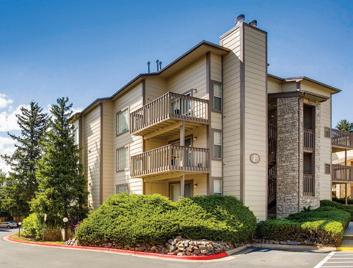
CHARTING THE COURSE
Perception of Inflation – Falling or Still Too High? –Will Tell the Tale in November
FINDING YOUR PATH
A Looming Crisis in the Banking Sector?
GUEST FEATURE
The Impact of AI on Apartment Investing
ZEITGEIST: NEWS HIGHLIGHTS
TRAILBLAZING
Point Loma Palms, Point Loma (San Diego), CA NOTABLES AND
QUOTABLES
/ Innovation 2 5 8 11 12 14 IN THIS ISSUE
April 2024
Disruption
THE PATHFINDER REPORT












CHARTING THE COURSE
Perceptions of Inflation – Falling or Still Too High? – Will Tell the Tale in November
By Mitch Siegler, Senior Managing Director

“Inflation is when you pay fifteen dollars for the ten-dollar haircut you used to get for five dollars when you had hair.”
- Sam Ewing, American Baseball Player
Much ink has been spilled during the past several years about inflation, which skyrocketed from next to nothing to the highest level in 40 years. Inflation, which peaked at 9.1% in June 2022 fell to 3.2% in February 2024. Good news, right?
Not so fast. The Federal Reserve’s target rate for inflation –when Fed governors will ease off the brake pedal and start loosening up on interest rates – is 2% and we haven’t had 2% inflation since 2020. Lest you’ve forgotten, that was during a global pandemic, when the economy slowed to a crawl.
Historically, sitting presidents are reelected two-thirds of the time – and 80% of the time if there is no recession in the election year. When the election year coincides with a recession, the President has won just 44% of the time and only 33% since World War II. (You’d have to go back to 1900, President William McKinley, to find an incumbent who was reelected during a recession.)
Eight months from the election, there are few signs of an impending recession. That said, kitchen table issues –like the price of milk, eggs and Cheerio’s – determine the winner of presidential elections more often than not. Americans profess strong feelings about a whole host of issues – from a woman’s right to choose, to immigration/ border policies, to foreign policy and more. But most of the time, Americans vote their pocketbooks.
So, what about the prices of milk, eggs and Cheerio’s? You glass-half-full types will be pleased to know that the price of milk fell 1.5% in 2023, according to the Labor Department’s Bureau of Labor Statistics. Yippee! You glass-half-empty types won’t be thrilled to learn that milk

THE PATHFINDER REPORT: APRIL 2024 2
$174,000,000 IN CURRENT COMMITMENTS 12 PROPERTIES, 1,383 UNITS ANY OFFERS TO BUY SECURITIES WILL BE MADE ONLY PURSUANT TO A CONFIDENTIAL PRIVATE PLACEMENT MEMORANDUM, WHICH WILL DESCRIBE IN DETAIL THE SECURITIES, INVESTMENT STRATEGY, AND RELATED RISKS. PATHFINDER PARTNERS INCOME FUND, L.P. A Stabilized Multifamily Fund www.pathfinderfunds.com Accredited Investors Can Participate in the Fund’s April 2024 Closing Aria Apartments Phoenix, AZ 76Units Maddox Apartments Phoenix, AZ 224Units Talavera Apartments Phoenix, AZ 144Units 88Units Breeze Hill Apartments San Diego, CA 41Units Vista Creekside Apartments San Diego, CA 56Units Highlands at Red Hawk Apartments Denver, CO 168Units Echo Ridge at North Hills Denver, CO 100Units V-Esprit Residences Denver, CO 31Units Paseo Village San Diego, CA 156Units Chestnut Apartments Denver, CO 195Units Charleston Apartments Sacramento, CA 104Units Passage Apartments Portland, OR

prices rose 13.2% in the past three years. (No crying over spilt milk jokes from us.)
And what about egg prices, averaging $2.14/dozen in January 2024? You’ll be happy to hear that egg prices are down 56% from their peak in January 2023. Good news isn’t always what it’s cracked up to be – egg prices have risen 52% since November 2019, just before the onset of the pandemic. That may explain why “eggs” were the #1 Google search topic in 2023 in the “Why are ____ (f*&#’ing eggs!) so expensive?” category?
Who cares about the prices of Cheerios, really? Well, did you know that 96% of consumers purchase cereal on every visit to the grocery store? And that Cheerios are the #1 cereal brand with a whopping 139 million boxes sold last year? Don’t think we’ve bought a box of Cheerios since our 20-something daughter was a toddler – and we’re shocked to see what they cost today!
In 2022, the average price of Cheerios rose 16.7%, from $6.86 to $8.00. While that’s a slower rate of inflation than for Life (17.7%) or Raisin Bran (19.7%), it’s in a different cupboard entirely than perennial favorites like Cap’N Crunch (up 41.9%) and Crunch Berries (up a whopping 114%! – sorry, kids – it’s gonna be Raisin Bran for a while), it’s clear that inflation bites at the breakfast table. And with limits to the prices consumers will pay for half a box of cereal and half a box of air, cereal manufacturers responded last year by adding more air (er, shrinking portion sizes). Shrinkflation, they call it. Maybe it sounds less unpleasant?
As we ponder the question of whether the inflation story has a happy or a not so happy ending, we recall the wisdom of Groucho Marx: “There’s two types of people
in the world; Those who think people can be divided up into two types, and those who don’t.”
How does all this affect me, you ask? Well, absent a recession in 2024, don’t be surprised if the ’24 Presidential election turns on Americans’ view of inflation. Those who are pleased about the fall in the inflation rate from 9.1% to 3.2% in the past 21 months will likely vote one way. And those who chafe at the higher prices for groceries, cars and other stuff are likely to vote the other way. For the latter group, perception is reality.
And as they say on late night television, “but that’s not all.” There’s inflation on the stuff people buy every day. There are also higher costs on capital goods – homes and vehicles – driven by higher interest rates. Let’s spend a minute unpacking that.
The January 2024 inflation “print” ran hotter than expected. The February inflation rate was also higher than expected. At its mid-March meeting, the Federal Reserve governors signaled a possible rate cut in June. Pundits – who just a couple of months ago were forecasting six interest rate cuts this year – are now talking about three – and at least one would likely come only in November-December – following the election. So, this same dynamic (good news: rates are beginning to fall, finally vs. bad news: interest rates are still too darned high!) will be at work all year on the second, very important driver of household expenses.

It’s hard to know now which way the inflation cookie will crumble. (We’ll save the discussion of higher Oreo® prices and less creamy filling in each cookie for a future issue.) We do know this: at a recent San Diego real estate conference, the chief economist for real estate brokerage

THE PATHFINDER REPORT: APRIL 2024 3
firm CBRE showed his forecast for the 10-year treasury rate through 2030. The 10-year is a helpful benchmark for understanding what you’ll likely pay for a mortgage or car/truck loan in the years ahead. At press-time, the 10year treasury rate was about 4.2%. CBRE thinks it will hover around 4.0% through 2030. That suggests it could be hard for borrowers – and consumers – to get any real relief from high interest rates and consumer prices.
America is polarized and the 2024 presidential election promises to be close. And the election will most certainly
be decided in six to eight swing states. There will be lots of twists and turns in the next seven months, but you can take this to the bank: Americans’ views of the economy –and inflation in particular – will play a meaningful role in determining our nation’s leadership in the years ahead.
Mitch Siegler is Senior Managing Director of Pathfinder Partners. Prior to co-founding Pathfinder in 2006, Mitch founded and served as CEO of several companies and was a partner with an investment banking and venture capital firm. He can be reached at msiegler@pathfinderfunds.com.

THE PATHFINDER REPORT: APRIL 2024 4
FINDING YOUR PATH
A Looming Crisis in the Banking Sector?
By Lorne Polger, Senior Managing Director

A potential crisis in pockets of the banking sector related to commercial real estate loans is emerging. This could have profound impacts and create interesting investment opportunities for the next few years. Several factors are at play.
Overvaluation of Properties that Comprise Collateral for Bank Loans
Commercial real estate was overvalued from 2021 through 2023 due to speculative bubbles and unrealistic expectations caused in part by the ultra-low interest rate environment. As Pathfinder has been saying since our founding back in 2006, trees just don’t grow to the sky. Many investors (and their lenders) placed speculative bets on continued short-term appreciation and oversized rent growth (across all sectors of commercial real estate). It worked until it didn’t.
Many of those acquisitions were financed with shorterterm debt, which is coming due. As interest rates rose and rents stagnated, capitalization rates (the benchmark behind real estate valuations) began to rise behind them, resulting in lowered values. And then on top of that, the hard-hit sectors, like office, got hit harder, as vacancies, particularly in central business districts, rose to near unprecedented levels. As the market continues to correct, lenders holding these loans may have to start taking losses from mark-to-market rules, loan covenant and monetary default violations, loss reserves, short sales or in some cases, foreclosures.
As recently reported in Globe St., quoting from the Fed’s January 2024 meeting: “Vulnerabilities in the financial sector remain notable, as losses in the fair value of longdated bank assets remain significant.” Risk-based capital ratios are “well above regulatory minimums, driven both by robust bank profitability and by a decrease in shareholder payouts at the largest banks,” the article continued.

However, while “credit quality at banks remained strong,” the “quality of CRE loans backed by office, retail, and multifamily buildings continued its decline.” And it’s not just remote work that is causing the problem. The Fed noted that “Commercial real estate (CRE) prices continued to decline, especially in the office, retail, and multifamily sectors, and low levels of transactions in the office sector likely indicated that prices had not yet fully reflected the sector’s weaker fundamental…Some smaller regional and community banks with high concentrations of CRE loans are also highly reliant on uninsured deposits, potentially compounding vulnerabilities.”
Translation: When portfolios of loans are based on properties with falling valuations, the values of the loans are reduced, opening the potential for an inability to refinance, and further pushing on how long banks can carry loans at full value on their balance sheets.
During Treasury Secretary Janet Yellen’s remarks to the Senate banking committee in February, she noted that valuations are falling, and that stress and losses will be forthcoming. Yellen stated: “I hope and believe that this will not end up being a systemic risk to the banking system. The exposure of the largest banks is quite low, but there may be smaller banks that are stressed by these developments.”
According to a recent report from the banking industry consulting firm, Klaros Group, nearly 300 banks with heavy CRE exposure could need a capital infusion or require a merger with another institution to avoid failure. CNBC reported that the study found that 282 banks with $900 billion in total assets have real estate loans that make up more than 300% of their capital and

THE PATHFINDER REPORT: APRIL 2024 5
have a high proportion of unrealized losses on low-interest loans made before the Fed started its aggressive rate-hiking campaign.
Commercial Property Debt Concentrated in Small Banks
Most banks at risk are community banks with less than $10 billion in assets, Klaros found. Of the 4,000 banks the firm analyzed, more than 7% were deemed as under stress. That becomes a bit of a tightrope walk for regulators who do not want to see another repeat of the 2023 bank failures that were caused by embedded losses in securities investments.

Banks with assets below $20 billion hold 56% of the commercial real estate property loans in the U.S. (See chart below courtesy of Visualcapitalist.com)
If credit losses accelerate and CRE valuations continue to decline, those banks run a higher risk of failure. Most certainly, they will be more closely scrutinized by the regulators. Community banks are more susceptible to taking hits from write-downs. Now not all smaller banks are heavy on exposure to the riskier classes of real estate. But some went overweight in the sector while the markets were heating up; those banks have the most exposure today.
Embedded Losses
Embedded bank losses, through unrealized securities and loan mark-to-market losses, stood at $700 billion at the end of 2023. If long-term treasury yields don’t fall (or gulp, rise again!), we may see greater pressure on banks to mark their investment portfolios to market and take that hit now.
Upcoming Wave of Loan Maturities
Adding to the woes – nearly $1 trillion of commercial real estate loans are expected to mature in 2024 alone, according to the Mortgage Bankers Association, of which $441 billion is held by banks. About 20% may be in the most vulnerable category (office). So, here’s the scenario. Bank made a loan on an office building in 2021. The building was worth $30 million at the time and the bank made a conservative loan of $20 million.

Today, the building is 60% occupied and worth $20 million on a good day. Most banks would loan about 50% on that deal today, call it $10 million. Who makes up the shortfall? Does the bank extend the current loan at 100% loan-to-value? Likely not. Perhaps, for a good customer, they will ask for a significant paydown for a year to give the borrower some hope for the future. But they won’t do that forever. And if the borrower sees that the ship is sinking, some will just toss the keys back. Not pretty.
Persistent Inflation
Banks continue to hope that the Fed will begin cutting interest rates this summer, which could ease pressure on struggling banks. That said, earlier predictions of four to six cuts in 2024 have been reduced to predictions of only three, as hotter-than-expected inflation to start 2024 has tempered the enthusiasm for reductions.
The banking sector is a bit of a lagging indicator. Following the global financial crisis, credit losses peaked two years after delinquencies did. Clearly there is still pain to come, even if the Fed begins moderating rates later this year.
Sector-Specific Challenges
Certain sectors within commercial real estate, specifically office, are facing unique challenges due to changes in work behavior and technological disruptions. As office occupancy continues to dip (downtown markets appear most susceptible; two markets that we regularly track, San Diego and Denver, are showing downtown office vacancy rates at historically high levels, over 30%), office loans are at higher risk of default.
THE PATHFINDER REPORT: APRIL 2024 6
Source: Visualcapitalist.com “ The U.S. Banks With the Highest Exposure to Commercial Real Estate” by Niccolo Conte

By example, Denver currently has eleven office buildings in some form of receivership or foreclosure. We believe that the number will increase, and we expect to see the same trend line across many markets. For those lenders with heavier exposure to office, those loans could result in significant hits to capital. You can only kick the can so far down the road…
Bank Regulator Requirements
At some point, bank regulators will require banks to mark down some of those loan portfolios in ways similar to the required mark downs of investment portfolios. Our belief is that is when the pain will come. Those appraisals tucked in the files from 2022? Pretty worthless these days. When true values are updated and debt coverage tests are conducted, we will then begin to see some of the wheat separating from the chaff. And it’s not going to be pretty.
Opportunities
Notwithstanding the headwinds, we see opportunities both within the banking sector and for real estate investors.
Within the sector, we think there will be new lending opportunities for those banks that are not currently overweight in CRE loans. Those banks will seek opportunities from well capitalized borrowers who may be able to opportunistically purchase properties and loans at significant discounts to peak pricing. For the buyers, it’s all about a reset in basis. For example, if an asset that previously traded at $500/square foot is repriced to $200/square foot following a short sale or foreclosure, and the new lender can now lend 60% of that value, that lender can likely feel confident about that value/loan basis, especially as it compares to the replacement cost of the property.
On the investment side, we believe that the acceleration of problems in loan portfolios will lead to interesting investment opportunities at attractive prices across the CRE sector. Perhaps not the scope of opportunities that we saw during the Great Financial Crisis, but we don’t believe that the days of “extend and pretend” will be with us during the current period of heightened regulatory scrutiny.
Lorne Polger is Senior Managing Director of Pathfinder Partners. Prior to co-founding Pathfinder in 2006, Lorne was a partner with a leading San Diego law firm, where he headed the Real Estate, Land Use and Environmental Law group. He can be reached at lpolger@pathfinderfunds.com.

THE PATHFINDER REPORT: APRIL 2024 7
GUEST FEATURE
The Impact of AI on Apartment Investing
By Scot Eisendrath, Managing Director

I remember the dot-com internet bubble in the late ’90s. Stock prices were going through the roof – the Nasdaq increased 800% from 1995 to March 2000, before falling 78% from the peak through October 2002, giving back most of the gains. I thought my portfolio of internet stocks would allow me to retire before age 30; it did not happen.
There were promises that the new internet technology would change the way we live – like autos in the ‘20s, TV in the ‘40s and PC’s in the ‘80s. There were losers – Pets. com, eToys.com and Webvan are no more – and winners (this was when Amazon started to take off). Internet technology did not change our lives overnight, but there is no disputing that today we can order something online in the morning from Amazon and receive it that evening (or the next day), which is a life changer.
Artificial intelligence or AI, per Wikipedia, is the “intelligence exhibited by machines, particularly computer systems, as opposed to the natural intelligence of living beings”. We see AI in our daily lives with internet searches, GPS systems, digital voice assistants, smart home devices and Netflix recommendations, to name a few. What has made the biggest splash recently is generative AI, which uses AI to create new content, such as text, images, audio and videos. Generative AI really demonstrates the power of AI and the future of the technology. (Full disclosure: I used the generative AI tool Chat GPT as a starting point for this article!)
AI feels eerily like the ‘90s internet craze – a revolutionary technology that shows promise to change the way we live, followed by stock market euphoria around companies with AI technology. NVIDIA Corp., a Silicon Valleybased technology company that is the dominant supplier of AI hardware and software, has seen its stock rise over 70% in just the past 12 months, becoming a $2.4 trillion
company by market capitalization and helping to fuel overall gains in the broader stock market. AI technology may not feel like a game changer today, but it will be, maybe sooner than we think.
The real estate industry is notoriously inefficient and slow to embrace technological change. I can remember starting as a young real estate analyst in the brokerage industry in the mid-1990s. I was armed with a business school education along with fancy financial Excel models, prepared to determine real estate transaction values using the discounted cash flow approach. I will never forget a lecture by a successful real estate veteran that “we are selling bricks and mortar, not IRR’s (Internal Rates of Return)!”
Oh, how things have changed as our industry has matured. While investors are buying bricks and mortar, as our industry has become more institutionalized, it has become apparent that sophisticated investors are buying an income stream – good real estate produces a dependable stream of cash flows. I saw that broker go from a market leader to a follower because he did not embrace technology and the new way of doing things. I believe that AI is similar in that the early adopters of the new technology will be the likely winners.

How will AI affect apartment investing? Where can we become more efficient, get a leg up on our peers, streamline our operations and processes, become smarter at how we do things? This is probably just the beginning, but I believe there are three key areas where AI will have an impact on apartment operations and investing in the near term: market research, asset and property management and marketing and tenant selection.

THE PATHFINDER REPORT: APRIL 2024 8
The adage that you make money on the buy in real estate is often true. Market rent growth, and resulting apartment values, are most dramatically impacted by population growth, household formation and employment and wage growth. If we can invest in an area that is flourishing in these areas, demand for apartments should increase and our target residents will have the income to pay higher rents. AI gives real estate investors the ability to analyze vast amounts of data to determine market trends, analyze key economic indicators and gain improved understanding of demographic data to better predict property performance and rental demand. This helps with initial asset selection, but also mitigates risk –data can show where not to invest or when to dispose of a property because the market fundamentals are deteriorating, or growth is slowing. Being able to analyze more data faster makes us smarter, helping to make better decisions on acquisition, pricing and optimizing a portfolio. Better analysis – aided by AI – makes for better investment decisions and performance.
Asset and Property Management
Asset and property management are the blocking and tackling of apartment investing. Managing better enables you to turn a good investment into a great investment.
I’ve looked at many operating statements for potential acquisitions, and many times there is low hanging fruit – delinquency that is double what we average in our portfolio, bloated operating expenses, other revenue sources that aren’t being tapped. If we take one of our core competencies and make it even better – bingo, increased value for our properties and our investors.
AI has great promise to make property management more efficient. Computers can handle routine, repetitive tasks that take up time for property managers, such as rent collection, maintenance scheduling and lease administration. This allows people to focus on more important activities, such as tenant screening, building relationships with tenants and lease renewals.
We recently implemented AI collections software at some of our properties. Calling non-payers is not only time consuming, but also creates friction between onsite staff and residents. The AI collections software is expected to

reduce delinquency by 20%, free up onsite employees’ time and make employees’ interactions with residents more pleasant.
There are also some tasks that computers just do better. In our portfolio, we have gone from roving security guards to a live monitoring security system that is powered by AI. Not only does the live monitoring security system do a better job (how often does a security guard catch a problem during the three or four times they drive by a property for a few minutes at night?), but it is also saving us real money, which falls straight to the bottom line.
Marketing and Tenant Selection
During my career, I have seen annual advertising and marketing budgets increase from $150/unit to $500+/ unit, and that is just to stay competitive. AI promises to make marketing campaigns more focused, identifying target demographics and tailoring campaigns to more desirable prospective tenants. This is expected to result in more personalized communications with prospective residents, and a higher leasing success rate. Leasing “bots” on property websites are one form of AI; while impersonal, they do offer an important option – they can respond to questions in real time and at the preferred schedules of potential residents, which is often outside of regular office hours.
There are also AI applications that assist with resident screening, helping us flag potential problem tenants prior to signing a lease. Through AI, we should be able to better predict a tenant’s ability – and willingness –to pay rent, and avoid costly bad debt, attorney’s fees, eviction costs and downtime between leases.

THE PATHFINDER REPORT: APRIL 2024 9 Market Research
Challenges Implementing AI into Apartment Operations
There are pitfalls and challenges that need to be considered in the implementation of AI into our business. Ever go to a website and get frustrated that you are dealing with a bot as opposed to a person? AI can negatively impact a customer’s experience if it is not used properly. AI can also go awry when it uses historical data to predict the future if it lacks a key ingredient –human intuition and judgment. Data validation is a potential red flag – garbage in results in garbage out. AI will require human interaction in the form of ongoing monitoring to maintain accuracy and effectiveness – my job won’t be totally replaced by a computer, but AI could make me more efficient and effective!
Looking ahead, AI promises to transform real estate investing, offering investors extraordinary opportunities to improve property selection and operational performance. Embracing AI to help source, analyze, acquire, manage and dispose of real estate assets should allow investors to take advantage of the technology to enhance investment returns.
R2D2 and I are looking forward to what the future will bring!
Scot Eisendrath is Managing Director of Pathfinder Partners. He oversees the firm’s financial analysis and underwriting and has spent more than 25 years in the commercial real estate industry with leading firms. He can be reached at seisendrath@pathfinderfunds.com.

THE PATHFINDER REPORT: APRIL 2024 10
ZEITGEIST –SIGN OF THE TIMES
The Solution to Housing Affordability is More Supply
According to a recent National Low Income Housing Coalition (NLIHC) report, extremely low-income households – those who earn 30% of the median income – account for nearly a quarter, or 11 million, of the nation’s renters. About 74% of them are severely cost-burdened, spending over half of their income on rent. The root cause of this (and many housing-related challenges, generally) is a lack of supply.
For decades, housing advocates have been pounding the table for more multifamily construction to help boost supply, the most important step in alleviating the affordability crisis. In 2021-2022, a combination of low interest rates and top-of-the-market enthusiasm spurred a major increase in multifamily construction starts. According to CBRE , over 900,000 multifamily units are under construction and approximately 440,000 of those units are scheduled to be delivered in 2024, the highest levels since the 1980s. The new supply has temporarily cooled rent growth, increased rental concessions and helped overall affordability.
Ultimately, the new supply being delivered is nominal relative to the total shortfall and will not resolve the longterm issue. And due to the high cost of construction, most of the new product being delivered is Class-A with relatively high rents. Additionally, the current level of new supply is temporary with higher interest rates forcing developers back onto the sidelines. According to CBRE, housing starts will fall almost 70% in 2024 from their 2022 peak and 45% from their pre-pandemic average. This reduction in construction is expected to set the stage for higher occupancies and elevated rent growth in 2026 and beyond.

Why Your Current Tenant may be Your Best Tenant
With an historic number of new apartments being delivered in 2024, many landlords are shifting their focus from rent growth to tenant retention. When a tenant moves out, landlords must absorb additional costs, including vacancy, advertising and utilities. The leasing staff must focus on finding a replacement tenant and the unit often needs repairs, cleaning or painting before it can be shown to prospective tenants. According to RealPage and MRI Real Estate, apartment turnover costs landlords $4,000 per unit and the average annual renter turnover is 46%. Reducing turnover, even by a few percent, can greatly improve a property’s bottom line.
According to Turnkey Properties, over 60% of tenant turnover is controllable, with the performance of the onsite management, leasing and maintenance staff being the largest contributing factor. At properties where staff communicate effectively with tenants, hold frequent resident events (e.g. happy hours, summer pool parties and food trucks) and quickly resolve maintenance issues, turnover can be reduced, and profitability improved. Retaining tenants can also foster a greater sense of community, helping with resident referrals and online reviews. Ultimately, a focus on tenant retention boosts a property’s bottom line while contributing to a more positive living experience for residents; a classic win-win.

THE PATHFINDER REPORT: APRIL 2024 11
TRAILBLAZING: POINT LOMA PALMS, POINT LOMA (SAN
DIEGO),
CA
“Coastal Living where California Begins”

In 1542, the maritime explorer Juan Rodriguez Cabrillo became the first European to set foot in California on the east shore of Point Loma, leading historians to designate the land as “where California began”. Point Loma is a peninsula between the Pacific Ocean and San Diego Bay known for its treelined streets, diverse architecture and picturesque beaches. The area is also home to Point Loma Palms, a 1968-vintage, 25-unit apartment community that Pathfinder acquired in 2020.
Point Loma Palms includes a mix of one and twobedroom apartments averaging 600 square feet with private patios (first floor units) and vaulted ceilings (second floor units). At acquisition, one unit was unpermitted and minimal upgrades had been completed in over 50 years.

Pathfinder’s common area renovations include new paint, signage and fencing, façade and landscaping enhancements, live-monitoring security cameras and the addition of a bike/storage room.

THE PATHFINDER REPORT: APRIL 2024 12
Point Loma Palms – Prior To Renovation
We also permitted the unpermitted apartment and renovated all interiors with the installation of washer/ dryers and updated bathrooms, kitchens, living rooms and bedrooms. The apartments feature an open floor plan and a built-in desk to accommodate tenants who work remotely.
The property is walking distance to live concerts and sporting events at the Pachanga Arena and a short drive from downtown San Diego, San Diego Bay and several beaches. There are numerous historical sites and parks nearby including the 46-acre NTC Liberty Station Waterfront Park and the 68-acre Sunset Cliffs Natural Park, a favorite destination for tide pooling, hiking and sunsets.
We are grateful to be a part of this remarkable community and to provide a secure and comfortable living environment at Point Loma Palms.

Point Loma: Did you know?
In 2022, the San Diego City Council selected the Midway Rising development team to pursue the redevelopment of the 48-acre Pachanga Arena site, three blocks north of Point Loma Palms. The initial plan includes 4,250 housing units, a 16,000-seat sports arena, a multi-acre urban park and a mixed use entertainment, arts and cultural distrcit.
The City of San Diego and Midway Rising are engaged in negotiations to refine the details of the development and the project is expected to be completed by 2035.


THE PATHFINDER REPORT: APRIL 2024 13
Point Loma Palms – Renovated Kitchen
Rendering of Midway Rising Development
NOTABLES AND QUOTABLES
“Disruption / Innovation”
“Change is inevitable, and the disruption it causes often brings both inconvenience and opportunity.”
- Robert Scoble, American Author
“If you always do what you always did, you will always get what you always got.”
- Albert Einstein, German/American Physicist
“The greatest danger in times of turbulence is not the turbulence, it is to act with yesterday’s logic.”
- Peter Drucker, Austrian/American Businessman
“Disruptive innovation can hurt, if you
are
not the one doing the disruption.”
- Clay Christens, American Academic
“There’s
a way to do it better – find it.”
- Thomas Edison, American Inventor
“

“Think big, think disruptive. Execute with full passion.”
- Masayoshi Son, Japanese Businessman
“There is nothing permanent except change.”
- Heraclitus, Greek Philosopher
“Disruptors don’t have to discover something new; they just have to discover a practical use for new discoveries.”
- Jay Samit, American Author
“Learning and innovation go hand in hand. The arrogance of success is to think that what you did yesterday will be sufficient for tomorrow.”
- William Pollard, American Physicist
THE PATHFINDER REPORT: APRIL 2024 14
“
IMPORTANT DISCLOSURES
Copyright 2024, Pathfinder Partners, L.P. (“Pathfinder”). All rights reserved. This report is prepared for the use of Pathfinder’s clients and business partners and subscribers to this report and may not be redistributed, retransmitted or disclosed, in whole or in part, or in any form or manner, without our written consent.
The information contained within this newsletter is not a solicitation or offer, or recommendation to acquire or dispose of any investment or to engage in any other transaction. Pathfinder does not render or offer to render personal investment advice through our newsletter. Information contained herein is opinion-based reflecting the judgments and observations of Pathfinder personnel and guest authors. Our opinions should be taken in context and not considered the sole or primary source of information.
Materials prepared by Pathfinder research personnel are based on public information. The information herein was obtained from various sources. Pathfinder does not guarantee the accuracy of the information. All opinions, projections and estimates constitute the judgment of the authors as of the date of the report and are subject to change without notice.
This newsletter is not intended and should not be construed as personalized investment advice. Neither Pathfinder nor any of its directors, officers, employees or consultants accepts any liability whatsoever for any direct, indirect or consequential damages or losses arising from any use of this report or its contents.
Do not assume that future performance of any specific investment or investment strategy (including the investments and/or investment strategies recommended or undertaken by Pathfinder) made reference to directly or indirectly by Pathfinder in this newsletter, or indirectly via a link to an unaffiliated third-party web site, will be profitable or equal past performance level(s).
Investing involves risk of loss and you should be prepared to bear investment loss, including loss of original investment. Real estate investments are subject to the risks generally inherent to the ownership of real property and loans, including: uncertainty of cash flow to meet fixed and other obligations; uncertainty in capital markets as it relates to both procurements of equity and debt; adverse changes in local market conditions, population trends, neighborhood values, community conditions, general economic conditions, local employment conditions, interest rates, and real estate tax rates; changes in fiscal policies; changes in applicable laws and regulations (including tax laws); uninsured losses; delays in foreclosure; borrower bankruptcy and related legal expenses; and other risks that are beyond the control of Pathfinder or the General Partner. There can be no assurance of profitable operations because the cost of owning the properties may exceed the income produced, particularly since certain expenses related to real estate and its ownership, such as property taxes, utility costs, maintenance costs and insurance, tend to increase over time and are largely beyond the control of the owner. Moreover, although insurance is expected to be obtained to cover most casualty losses and general liability arising from the properties, no insurance will be available to cover cash deficits from ongoing operations.
Please add msiegler@pathfinderfunds.com to your address book to ensure you keep receiving our notifications.

THE PATHFINDER REPORT: APRIL 2024 15





























